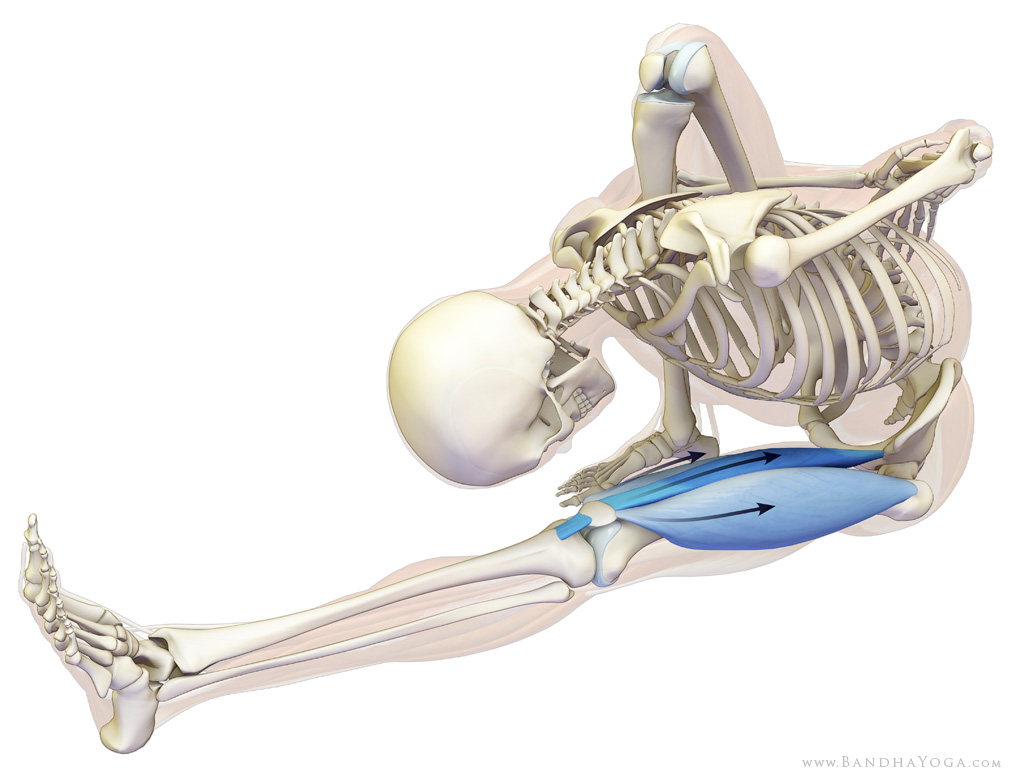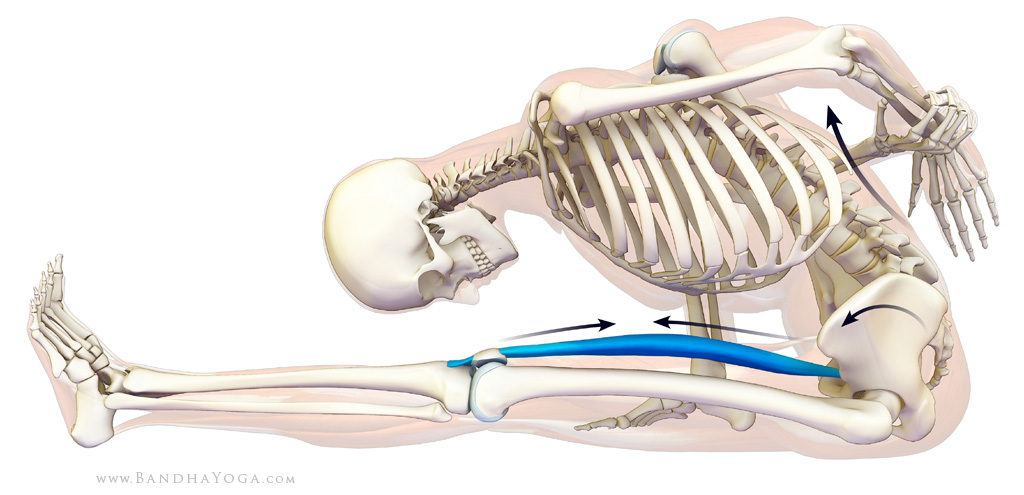In our last post we mentioned that true caution is based on accurate knowledge and wisdom; practicing it in yoga enhances benefits and minimizes risks. In this post, we talk about misguided caution and provide a couple of examples. This type of caution is usually based on fear: If you do “this”, a bad thing will happen. In fact, misguided cautions can enhance the risks and diminish the benefits of yoga because following them, among other things, diverts your focus from what is important. Think about it like this: You’re driving along the freeway and, for no reason, your passenger gets scared and yells, “STOP!” So you put on the brakes when you should apply the gas. The result is a pile-up. It's a type of passive aggressive way to decrease benefits and increase risks.
Two widely circulated examples of misguided caution relate to engaging the quadriceps in various yoga poses. One is that people with strong quads and misaligned kneecaps experience rapid progression of arthritis, and the second is that we should avoid contracting the rectus femoris in forward bends because it can cause “congestion”. Neither of these misconceptions has any basis in science, yet they are prevalent and have been incorporated into the curriculum of yoga, creating a conflict among teachers and practitioners. This has resulted in many teachers discouraging students from engaging these important muscles for fear of potential injury. I’ll address each of these “cautions” in turn later in the post, but in order to help resolve this conflict, let’s go over some of the basic science for the muscles and joints and then look at the benefits of engaging the quadriceps in a forward bend like Marichyasana I.
As I discuss in my books, joint stability is determined for each individual articulation by a combination of three factors: bone shape (ball and socket vs. hinge, etc.), the capsule and ligaments, and the muscles. At the joint, the bones are covered with articular cartilage. This cartilage and the ligaments surrounding the joints should be protected during a stretch. Stretching ligaments beyond about 6% of their normal length (from which they still recoil) can result in loss of their contribution to stability, especially if done on a regular basis. Unstable joints become incongruent; their surfaces do not match perfectly according to their design. When joint surfaces become incongruent, this can damage the articular cartilage and lead to arthritis. The muscular stabilizers form a type of dynamic sleeve around the joints and aid in protecting them by maintaining joint congruency. This concept is well supported, especially by experts in body weight training (a time-honored system similar to gymnastics that uses the body weight itself for conditioning, rather than external weights).
The beneficial effect of activity—which necessarily includes muscular engagement, especially the quadriceps—on joint cartilage is also supported by the peer-reviewed medical literature, including a recent review1 of articles evaluating the effect of activity on the knee joint. The theory behind this is that cartilage responds positively to judiciously applied forces. One of the reviewed articles states:
In conclusion, we demonstrated a protective effect of past and current vigorous physical activity on knee cartilage in healthy, community-based adults with no history of knee injury or disease.2
 |
| The quadriceps stabilizing the knee joint in Marichyasana I. |
Next, let’s take a look at the cascade of beneficial effects that ensues when you do engage the quadriceps of the extended knee in Marichyasana I. This includes: 1) improved joint alignment and stability at the knee; 2) release of the hamstrings through reciprocal inhibition (so that lengthening occurs in the muscle belly, rather than overstretching in the tendons); and 3) the rectus femoris synergizes the psoas in flexing the hip and tilting the pelvis forward. This aids in preventing hyperflexion of the lumbar spine in the pose through joint coupling (lumbar-pelvic rhythm). (For those who tend to hyperextend the knee, use co-contraction of the quadriceps and hamstrings to maintain alignment).
 |
| The rectus femoris synergizing anterior tilt of the pelvis. |
This is only one example of one muscle benefitting a pose; obviously we don’t engage all of the muscles at once in any given pose and may even relax completely in certain restorative poses. What I recommend is incorporating periodic muscular engagement into your practice—I call this “walking around the pose”. In addition to the benefits described, practicing in this way establishes the mind-body connection and focuses attention, thus creating a meditative state within a hatha yoga practice. The Mat Companion series takes you through the muscles involved in stabilizing the joints in the asanas as well as cues for engaging them—and much more. Feel free to browse through this collection at the Bandha Yoga website.
Now, let’s look at the two examples of misguided caution that we cited earlier:
The first states that “people with strong quads and misaligned kneecaps experience rapid progression of the disease” (arthritis). This is apparently a distorted interpretation of a peer-reviewed article (to put it charitably) that was circulated in 2011. I discussed it in a previous blog post.
The second implies that contracting one of the heads of the quadriceps, the rectus femoris, causes “congestion”. Congestion, in the medical sense, is caused by an upstream blockage to the flow of blood (or lymph). A blood clot within a vein or a mass lesion (such as a tumor) pressing on it from the outside can cause congestion. It can also be caused at the capillary level through various pathological processes. Congestion is not caused by muscle contraction.
 |
| The rectus femoris in relation to the femoral artery and vein and inguinal lymph nodes. |
In fact, engaging muscles (like the rectus femoris) produces a “pumping” effect on both the lymphatics and veins, which improves venous flow and relieves“congestion”. One of the reasons that we mobilize patients as soon as possible after surgery is to access the pumping effect of muscle contraction and so prevent the development of venous thrombosis (a clot forming due to venous stasis).
 |
| Diagram of veins with one-way valves demonstrating pumping action of muscle contraction. |
Furthermore, the rectus femoris shares the same innervation as the other three heads of the quadriceps (the posterior division of the femoral nerve). Therefore, you cannot relax it without relaxing the rest of the quadriceps (even if you wanted to). Thus, attempting to relax the rectus femoris in isolation (to avoid “congestion”) is an example of attempting the impossible, out of fear of the imaginary, while at the same time avoiding the beneficial.
The risks of following either of these misguided cautions include: 1) diminished alignment at the knee, with potential adverse effects on the cartilage and ligaments; 2) overstretching of the hamstring tendons; 3) decreased anterior tilt of the pelvis resulting in lumbar hyperflexion (in forward bends); 4) loss of the pumping effect on the veins; etc. You get the picture.
Friends, the prevalence of knee pain is on the rise, as confirmed in the December 6, 2011 issue of the Annals of Internal Medicine.3Basing your practice and teaching on unsound theory has the potential to contribute to this pile-up, especially considering the number of people doing yoga today. Conversely, basing it on sound theory has the potential to provide some relief.
If you do suffer from knee pain or an injury, consult your physician; always work under a physician’s guidance to manage your condition.
Great to see you all and many thanks for your support and comments on our last post! Be sure to visit us on Facebook for your free Chakra poster and e-book. See you next week, when we’ll go over a technique for improving muscle control and proprioception that you can learn in Chaturanga and then apply to any pose!
Namaste’
Ray and Chris
.1. Urquhart DM, Tobing JF, Hanna FS, Berry P, Wluka AE, Ding C, Cicuttini FM. What is the effect of physical activity on the knee joint? A systematic review. Med Sci Sports Exerc. 2011 Mar, 43(3):432-42.
.2. Racunica TL, Teichtahl AJ, Wang Y, et al. Effect of physical activity on articular knee joint structures in community-based adults. Arthritis Rheum. 2007, 57:1261–8.
.3. Uyen-Sa D.T. Nguyen, DSc; Yuqing Zhang, DSc; Yanyan Zhu, PhD; Jingbo Niu, MD, DSc; Bin Zhang, ScD; and David T. Felson, MD, MPH.Increasing prevalence of knee pain and symptomatic knee osteoarthritis: Survey and cohort data. Annals of Internal Medicine. December 6, 2011, 155(11): 725-732.